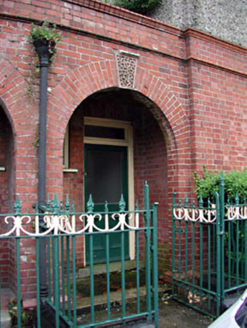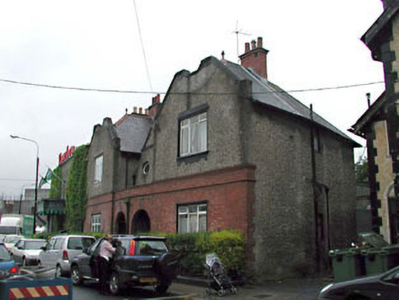Survey Data
Reg No
11814120
Rating
Regional
Categories of Special Interest
Architectural, Historical, Social
Original Use
House
In Use As
House
Date
1895 - 1915
Coordinates
289522, 219583
Date Recorded
27/01/2003
Date Updated
--/--/--
Description
End-of-terrace two-bay two-storey house, c.1905, retaining early aspect with round-headed open internal porch to left ground floor and single-bay two-storey advanced end bay to right (south). One of a pair. Gable-ended (shared) and hipped roofs with slate behind profiled parapets to gables. Red clay ridge tiles. Red brick chimney stacks. Red brick stepped coping to gable to party wall to left (north). Cast-iron rainwater goods. Red brick Flemish bond walls to ground floor. Red brick stringcourses to first floor. Roughcast walls to first floor with profiled parapet walls to gables (shared to left (north)). Rendered coping. Roughcast walls to remainder (including side elevation to south). Unpainted. Square-headed window openings. Rendered dressing to sill to first floor with moulded cornice over. Timber casement window. Bulls-eye window to right first floor. Moulded surround. Fixed-pane timber window. Square-headed door opening in round-headed open internal porch. Glazed timber panelled door. Overlight. Road fronted. Hedge boundary to front with section of iron railings to front of porch on cut-granite plinth.
Appraisal
This house, built as one of a pair (including 11814119/KD-19-14-119), is an early twentieth-century composition of typical Edwardian inventiveness that forms an attractive feature on Friary Road, leading on to Poplar Square to north. The house juxtaposes a red brick construction to ground floor with roughcast walls to first floor to picturesque effect, while the profiled parapet walls to first floor distinguish the design and add incident to the roofline of the streetscape. The house retains most of its original aspect with features and materials including timber casement windows, timber furniture to the door opening, and a slate roof. The railings to front are also goods examples of early surviving iron work.



